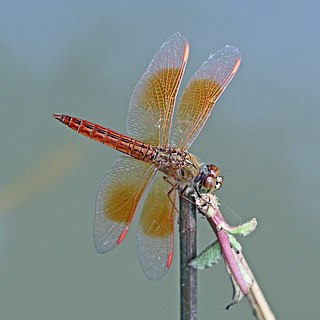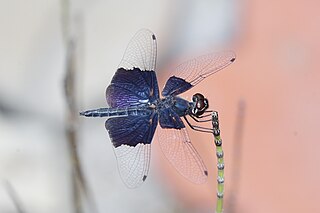
Neurothemis tullia, the pied paddy skimmer, is a species of dragonfly found in south and south-east Asia. It appears in Bangladesh, China, Hong Kong, India, Malaysia, Myanmar, Nepal, Sri Lanka, Taiwan, Thailand, Cambodia and Viet Nam.
Burmagomphus pyramidalis, the sinuate clubtail, is a species of dragonfly in the family Gomphidae. It is found in India and Sri Lanka. There are 2 subspecies, where they are geographically separated.
Heliogomphus walli, or Wall's grappletail, is a species of dragonfly in the family Gomphidae. It is endemic to Sri Lanka. It is also known as Wall's round-tip clubtail in some texts.
Megalogomphus ceylonicus, the Sri Lanka sabretail, is a species of dragonfly in the family Gomphidae. It is endemic to Sri Lanka.
Paragomphus henryi, the brook hooktail, is a species of dragonfly in the family Gomphidae. It is endemic to Sri Lanka.

Epophthalmia vittata, the common torrent hawk, is a species of dragonfly in the family Macromiidae. It is found in India, Sri Lanka, and Indonesia. Three subspecies recognized.

Aethriamanta brevipennis, scarlet marsh hawk, is a species of dragonfly in the family Libellulidae. It is found in many Asian countries.

Brachythemis contaminata, ditch jewel, is a species of dragonfly in the family Libellulidae. It is found in many Asian countries.

Cratilla lineata, the line forest-skimmer, emerald-banded skimmer or pale-faced forest-skimmer, is a species of dragonfly in the family Libellulidae. It is found in many Asian countries.

Diplacodes nebulosa is a species of dragonfly in the family Libellulidae. It is a widely distributed species in many Asian countries. and northern Australia.

Hydrobasileus croceus, the amber-winged marsh glider, is a species of dragonfly in the family Libellulidae. It is a widely distributed species in many Asian countries.

Indothemis carnatica, the black marsh skimmer, or light-tipped demon, is a species of dragonfly in the family Libellulidae. It is found in India, Sri Lanka and Thailand.

Indothemis limbata, the restless demon, is a species of dragonfly in the family Libellulidae. It is found in India, Sri Lanka, Myanmar, Singapore and Thailand. Two subspecies can be found.

Neurothemis intermedia, the paddyfield parasol, is a species of dragonfly in the family Libellulidae. It is widespread in many Asian countries. Four subspecies are recognized.

The marsh skimmer, also known as tricolored marsh hawk, and slender blue skimmer, is a species of dragonfly in the family Libellulidae. It is widespread in many Asian countries.

Palpopleura sexmaculata, commonly known as the Asian widow or blue-tailed yellow skimmer, is a species of dragonfly in the family Libellulidae. It is widespread in several countries in South, East and Southeast Asia, but is no longer believed to occur in Sri Lanka.

Rhodothemis rufa, the spine–legged redbolt, rufous marsh glider, or common redbolt, ( is a species of dragonfly in the family Libellulidae. It is widespread in many Asian countries.

Rhyothemis triangularis is a species of dragonfly in the family Libellulidae. It is widespread in eastern and southern Asia.

Macromidia donaldi is a species of dragonfly in the family Synthemistidae. It is known only from the Western Ghats of India and from Sri Lanka.
















